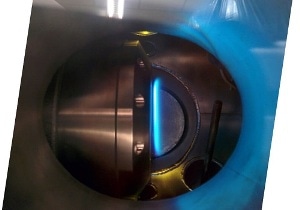Dec 5 2016
 A low-pressure flame used at KAUST to study ion chemistry. CREDIT: KAUST
A low-pressure flame used at KAUST to study ion chemistry. CREDIT: KAUST
Power stations that are cleaner and more efficient can be obtained with the characterization of compounds produced in combustion.
KAUST researchers have modeled the combustion of fossil fuels, resulting in the characterization of some of the components of methane, laying the foundations for greener power generation.
Incomplete combustion of fossil fuels, such as natural gas, during the production of energy, causes the discharge of air pollutants, such as nitrogen oxides, carbon monoxide, and soot, which are unsafe to the environment and the health of human beings.
The formation of these pollutants can be reduced by applying an external electrical field to monitor the combustion process. However, the mechanism for this is yet to be completely understood.
This encouraged Aamir Farooq and colleagues at the Clean Combustion Research Center at KAUST to develop a catalog of the compounds produced during the combustion of methane, the key component of natural gas, which could also lead to the design of less polluting power plants and extremely efficient gas turbines.
Controlling the charged particles allows a leaner, higher air-to-fuel mix, flame to be burned at lower temperatures, providing a more complete and efficient combustion of the fuel and a reduction in the formation of pollutants.
Aamir Farooq, KAUST
Cations, also known as positively charged particles, are formed when electrons are taken away from their atoms during the process of combustion. These positively charged particles are less abundant, mostly by many orders of magnitude, than the neutral molecules also developed, which makes the process of observing the formation and behavior of these ions a major technical challenge.
The researchers overcame this by using a McKenna burner to develop a low-pressure, stable methane-oxygen-argon flame. A custom designed molecular beam mass spectrometer was used by them to measure the ions produced in the flame, enabling them to be distinguished from the uncharged or neutral compounds that are more abundant.
We were able to measure a wide range of ions, allowing us to understand how they form and decay, and lead to the formation of other ions. A surprising and significant observation was the relatively large concentrations of ions other than hydronium.
Aamir Farooq, KAUST
The acidity of the flame is indicated by the presence of hydronium. Conditions for forming soot particles become more favorable when the flame is more acidic. Measuring its relative concentration is vital to decrease soot pollution. Detecting major deficiencies in existing ion models, the work recommends improvements for simulating ion behavior and formation. New research focuses on the ions developed from heavier compounds in natural gas, such as propane and ethane.
Our work is the first attempt to identify the cations formed in the combustion of low-pressure methane, and represents a major step towards the use of external electric fields for generating cleaner power.
Aamir Farooq, KAUST